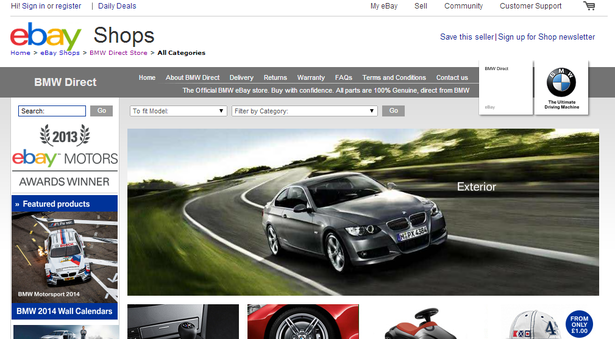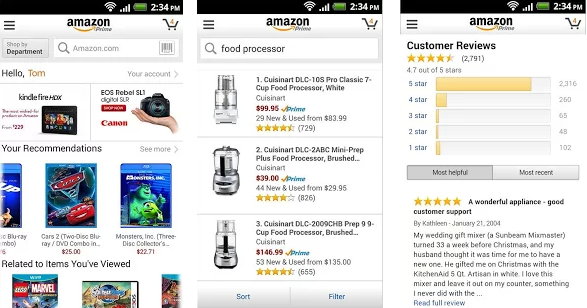
Advisors Must Stop Client Self-Destruction
February 5, 2014
Shadow Foreign Minister: The UK Government must challenge Russia on LGBT …
February 6, 2014 
There are many brands who have not considered selling on marketplaces like eBay and Amazon, let alone Ozon, Tmall and Allegro.
But it’s an opportunity only the foolish would dismiss out of hand. For many brands it can bring in another big chunk of revenue if done well and a customised page on eBay, for example, doesn’t necessarily devalue a brand’s image.
BMW are one example of a company that successfully dipped its toe, and then plunged into marketplaces. In fact, BMW used eBay before it had any of its own ecommerce functionality.
I attended the MetaPack Delivery Conference this week and heard from Al Gerrie of We Are Pentagon about the advantages of selling on marketplaces and what brands should look out for.
He also gave some detail on emerging marketplaces in growth areas such as Russia and China.
So what is there to know?
Which marketplaces?
- Amazon is a credible route into Europe. Yes, Amazon is also your competition, but more than 50% of Amazon’s product listings are now third party.
- eBay has 22 world marketplaces.
- Otto and Zalandro are burgeoning German marketplaces.
- Allegro in Poland is responsible for a third of all online transactions.
- Ozon is Russia’s main marketplace. eBay and Amazon are also in Russia. You can sell from the .com sites and Amazon will even auto-translate into Russian.
- Tmall in China is big. 90% of ecommerce in China is on marketplaces. On ‘singles day’, an ‘invented’ holiday, sales are bigger than Black Friday and Cyber Monday combined.
- Yahoo Japan and Rakuten are facing off for market share in Japan.
- Grays is an Australian marketplace to consider.
- Amazon may be preparing to open up third party selling direct to Mexico, India and Brazil. These markets, especially India for UK companies, could be huge.

The benefits
1. Premium brands can sell on marketplaces
Al mentioned Links, the jewellery retailer. It used marketplaces to sell surplus stock of London 2012 jewellery. The international market proved to be much keener for commemorative gifts, away from the saturated London and the UK.
As mentioned, BMW has used marketplaces, specifically eBay successfully. The brand has found it’s a good way to stay abreast of trends with second hand owners and the community by tracking who is buying spare parts.
Often, dealerships will lose contact with customers after warranties expire. The marketplace store, which is nicely branded, helps furnish BMW with more customer information.

2. Brands don’t have to discount
What’s more, brands can benefit from placing their entire catalogue on marketplaces. There’s nothing to lose.
3. Traffic
There’s more to the marketplaces, even on product types searches, than there is to many brand sites.
4. Localised offering
The sites are already customised to a specific country in many cases. For examples, eBay France is already optimised for the French audience, so why not take advantage.
5. Established payment providers
These are already in place to support your enterprise.
6. Low cost of entry
You can work with the marketplaces directly to design your store, or go through a third party.
Either way, it’s less hassle than setting up another of your own sites. In the Australian and US marketplaces there’s no translation needed either, obviously.
7. Mobile solutions
These are also ready-made for you. 30% of traffic to Amazon is via its app, so mobile revenue will likely receive a boost.

8. Year-round churn
Some products in the Northern hemisphere will sell seasonally, e.g. ski equipment in winter. But when sales are low, you can look to Australia, where skiing peaks in June.
This kind of dynamic allows for year round churn of many products.
9. New demographics
You might fight new audiences when users are searching for similar products but aren’t aware of your brand. If your products are surfaced for new demographics, this could dramatically increase the reach of your brand.
10. Test the water
It’s low risk, so you can dip your toe in fairly safely.
Potential downsides
Compliance varies by country
It’s important to know that products fit for sale in the US and the UK may not be fit for sale in, say, Germany.
Customer ownership
Be aware of what marketing rights you have. It may not be possible to market back to your customers from marketplaces, and doing so could land you in hot water.
Commission
You don’t get all the monies.
Integration
Integrating with marketplaces can be a new skill to get to grips with. Is third party software a better option?
What to bear in mind
Translation
Translation needs to be done by a human as language in the context of shopping differs from Google Translate (taken from UN translation archives).
Amazon will translate your store for Russian customers automatically, but it’s still something to bear in mind.
Delivery and returns
You need to understand this in each market. Russia is particularly complicated at the moment, with each customer subject to a total spend cap each month on imports, as Russia seeks to protect the domestic market.
Incidentally, the top 25 retail search terms on Yandex, the Russian search engine, are foreign fashion brands.
New legal entities
You may have to set these up.
Size conversion
This has to be calculated for clothes, shoes etc in each market.
Payment
Payment differs culturally. Some countries may prefer invoicing, like Germany, others like the Middle East prefer cash on delivery.
This can impact things like return rates and how your account.
Tax thresholds
The duty on wine, for example, changes between borders. Something to bear in mind when working out overheads.


